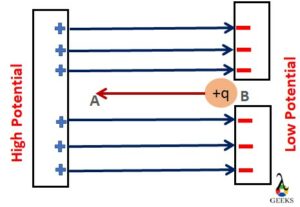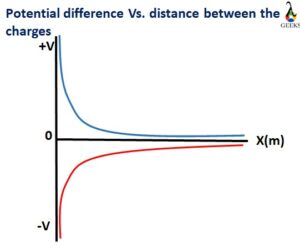A potential difference gives the amount of energy that the charges possess while moving from one point to another circuit.
Every circuit possesses a certain amount of potential difference because the charge always flows from one terminal to another terminal. By knowing this, there arises a question that can the potential difference be negative if the charge changes its direction? Let us discuss how it is possible to have a negative potential difference.
How can potential difference be negative
The answer to the question can the potential difference be negative is explained in the following section by considering a system of charges flowing in a circuit.
In a circuit, the charge flows from the positive terminal to the negative terminal, let say A to B. Charges at A have high potential, and charges at B have low potential. Here we do not take the exact potential possessed by the charge at both points. But we consider the difference in the charges’ potentials in points A and B. This is what the potential difference means.
Since the name itself tells it is a difference between the potentials between the two terminals of the circuit, the potential difference can be positive or negative.

The circuits are connected in such a way that the positive terminal of the circuit is connected to the positive terminal of the power supply. The negative terminal of the circuit is connected to the negative of the power supply. The potential is set up between the two terminals of the circuit, causing the motion of the charges by moving from high potential to low potential.
If in case the terminals of the connection are interchanged, i.e., connecting positive terminal to negative of the battery and the negative terminal to positive of the battery, such that the charges flowing from low potential to high potential; this causes the circuit to have negative potential difference.
When can potential difference be negative
Potential difference is the indicator of how much potential energy does a coulomb of charge possesses compared to the charge at the reference point.
If the potential energy of the charge at the reference point is more than the charge at the measured point, then the potential difference between those two charges is negative.
- Consider a positive charge in the space; the fields in the space are the reference point. If we want to move the charge away from the field, then the potential required to move the charge is less as there is a repulsive force between the positive charge and the field; thus, the potential difference will become positive.
- If we have used a negative charge instead, then we have to apply more potential to move the negative charge, as there will be an attraction between the negative charge and the field in the space. Hence more work is done on the charge to move further away; thus, the potential difference will become negative.

By Kirchhoff’s laws, assume the current is flowing in the direction as shown in the first figure; if the current direction is reversed in the loop direction, the potential difference is also reversed, and the measured potential difference exhibits negative potential difference.
For example, suppose the current is flowing in the loop from point P to Q. Assume that the measured potential difference between P and Q is +15V. If the current begins to flow from Q to P, i.e., the reverse in the direction of the current, then the measured potential difference between Q to P will be -15V.
How to find negative potential difference
Consider two charges: one is the point charge, and another one is the test charge. Let these charges move from point A to point B doing some work on the system. The charges have a VA amount of potential at point A and have a certain potential VB at point B.

In order to find how much amount of potential does the charges at point A and point B has is given by expression using Ohm’s law, as;
V = IR; where V is the circuit’s voltage, I is the current flowing through the circuit, and R is the resistance offered to the current flow.
From the equation, we can find the potential at A and B as;
VA = IARA; VB = IBRB
By using the above expression, the potential difference can be written as
∆VAB = VA – VB
The work done on the charge is proportional to change in the potential energy, the equation gives it;
W = -∆PE
The negative sign shows the work done is opposite the applied field direction by the negative charge.
When both filed, and the work is in the same direction, then the required equation will be
W = ∆PE
Work done on point charge by the field gives the potential as
V=∆PE/q
Since the charges are flowing from A to B, the potential difference is given by the equation
VAB=VA-VB=∆PE/q
If the flow of charge is from B to A, i.e., in the reverse direction, then the required equation will be a negative potential difference; given as
VAB=VB-VA=∆PE/q
Frequently Asked Question
Does negative potential difference mean negative voltage?
The term potential difference is a synonym for the voltage, which measures how much charge is flowing through the circuit.
The direction of the charges flow decides whether the circuit possesses a positive potential difference or a negative potential difference. Hence it is clear that the flow of charge is measured by voltage. Thus negative potential difference and negative voltages are the same.
Can the potential difference be zero?
Yes, one can have zero potential difference. From Ohm’s law, it is clear that, for a circuit to possess the potential difference, there must be the flow of current and sufficient resistance must be required.
If the charges do not possess the required amount of energy to overcome the resistance, then the flow of the charge carriers is restricted to conduct current. At this instance, the potential difference becomes zero as there is no movement of the charges.
Does the current flows if the potential difference is zero?
In the ideal case, yes, there will be a flow of current in an ideal conductor even though the potential difference is zero.
In real-world applications, the zero potential difference means there will be no flow of charges to conduct current through the circuit. The current can’t flow as the charges become stationary and possess more potential energy.
Does the negative potential difference decrease the rate of current flow?
The current flow rate is always the same for both positive and negative potential differences.
A negative potential difference means the charge cannot flow in the direction meant to flow. The charges have to change the direction of the flow in the circuit, i.e., in the opposite direction. That means the flow rate is not affected by the negative potential difference.
Also Read:
I am Keerthi K Murthy, I have completed post graduation in Physics, with the specialization in the field of solid state physics. I have always consider physics as a fundamental subject which is connected to our daily life. Being a science student I enjoy exploring new things in physics. As a writer my goal is to reach the readers with the simplified manner through my articles.